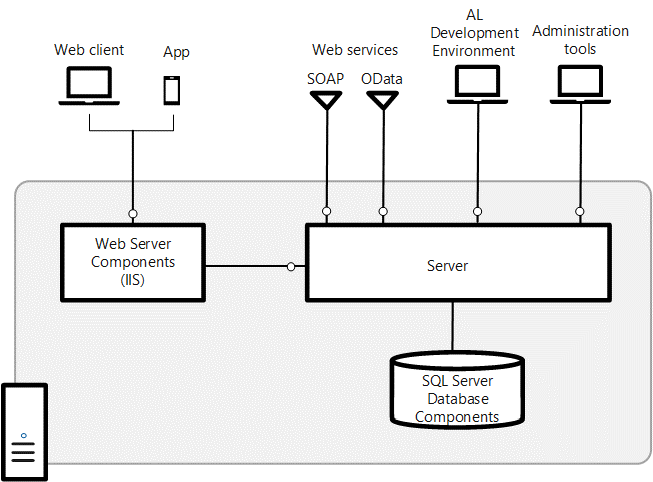Introduction - Cloud architecture for Business Central
Business Central is a full cloud solution, and its architecture is illustrated in the following diagram.
IIS, NST, and DB
An Internet Information Services (IIS) website is required to give users access to data from the Business Central Web client, companion app, and Microsoft Outlook add-in. This IIS website, which is referred to as a Business Central Web Server instance, hosts the files that provide content and services to client users over the internet.
The Business Central Web Server instance (IIS) connects to the Service Tier (NST), which in turn connects to the database (DB) that contains the application and business data. The Service Tier (NST) runs the business logic, which is stored in the App DB.
Web services
Business Central supports Web services based on SOAP and ODATA. Web services are industry-standard technologies that make application functionality available to a variety of external systems and users. Developers can create and publish functionality as Web services, where they can expose pages, codeunits, or queries, and even enhance a page's Web service by using an extension codeunit. When Business Central objects are published as Web services, they are immediately available on the network.
Business Central exposes an API that makes it possible to integrate with other services. Connect apps are typically created by using standard REST API to interchange data. Any coding language that is capable of calling REST APIs can be used to develop your Connect app.
Multi-tenant architecture
Business Central implements a multi-tenant architecture where the data is stored in an Azure SQL shared environment, and each tenant's data is stored in a separate database. The data schema is shared over all tenants of a certain localization. As a developer, you can use extensions to implement changes and additions to the data schema of your tenant.
Authenticating Business Central users with Microsoft Entra ID
Microsoft Entra ID is a cloud service that provides identity and access capabilities, such as for applications on Microsoft Azure, Microsoft 365, and for applications that install on-premises. Business Central Server instance is configured to use the AccessControlService credential type so that you can associate the Business Central user accounts with the Microsoft 365 accounts that people use to access the Business Central Web client, Microsoft 365, and SharePoint.
Administration of Business Central
If you are a Business Central reselling partner, you are the administrator of the Business Central tenants for your customers. You have access to the administration tools of their Microsoft 365 account and their Business Central administration center where you can specify upgrade windows, for example.

